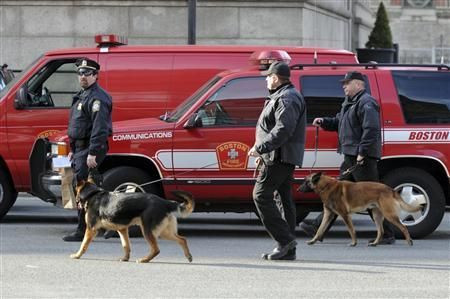Boston Marathon Crime Scene: How Forensic Techniques Might Point Toward The Perpetrator

The next few days of the investigation into the Boston Marathon bombings will be an intense forensic exercise, as officials analyze a mountain of videos and photographs and sweep a 12 city-block area looking for evidence.
“This is the most complex crime scene we’ve dealt with in the history of our department,” Boston Police Department Commissioner Ed Davis said at a news conference on Tuesday morning.
Processing the crime scene around Copley Square could take several days, officials said.
The U.S. Federal Bureau of Investigation is leading the probe, which involves Massachusetts state police, Boston Police, and special explosives experts from the Bureau of Alcohol, Tobacco and Firearms, among other agencies.
The FBI isn't yet commenting on the nature of the two devices used in the Boston bombings. Some experts say the preliminary evidence points toward a pipe bomb device. This kind of bomb, made from a tube (usually metal or plastic), capped with both ends and filled with explosive material, is one of the most commonly encountered explosive devices in the U.S.
Fred Burton, a former special agent from the Diplomatic Security Service division of the State Department, told U.S. News and World report that the explosive plume from one of the blasts was what you might expect from a high-powered pipe bomb. FBI veteran Paul Fennewald said white smoke from the blasts suggests the device used black or smokeless powder, not plastic explosives or C-4.
Recovering DNA evidence that could point toward the perpetrator is no easy task. A study published in the Journal of Forensic Science in 2004 found that they could pick up DNA from metal or PVC pipe fragments in just four out of 20 cases – and those experimental bombs were subject to low-grade explosions with smokeless powder.
“The variables that appeared to have the greatest influence on the success of generating a DNA profile were the amount of fragmentation and subsequent recovery of the bomb fragments,” the authors wrote. “It is suspected that successful DNA profiling could also be dependent upon the bomb assembler’s propensity to slough skin cells on objects they handled.”
While it might be hard to lift genetic material off of a pipe bomb itself, investigators may have more luck with the packaging material around a bomb. Tape, envelopes, switches, or whatever the bomb was concealed in could harbor just enough saliva, sweat or skin cells to offer clues.
Some ATF agents will be using specially trained dogs to search for unexploded devices, as well as residue from the explosion. Finding even the tiniest bit of evidence at a crime scene is a task that canines are ideally suited for. Some scientists estimate that a dog’s nose is 10,000 to 100,000 times better at sniffing than our own. Whereas we might be able to detect a teaspoon of sugar in a cup of coffee, a dog could sniff out a teaspoon of sugar diluted in a million gallons of water, Barnard College dog researcher, Alexandra Horowitz, told NOVA.
If there’s some evidence that manufactured explosives were used in the Boston attack, these might be traced throughout the supply chain via the U.S. Bomb Data Center, a division of the ATF, which collects information from manufacturers.
Officials will also be analyzing the pattern of damage and injuries sustained from the explosion to better understand just what the bomb was made of, the exact location of the device and which direction the blast traveled in. If there’s a crater left behind, investigators can estimate the weight of the bomb based on the crater’s diameter.
Of course, forensics is just one part of the investigation. The coming days and weeks will see witnesses interviewed, trails followed and, possibly, some glimpses of answers.
© Copyright IBTimes 2024. All rights reserved.





















